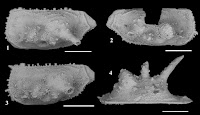Amphipods are small Crustaceans found in almost all modern marine ecosystems, as well as many freshwater environments; most freshwater 'Shrimps' are Amphipods, as are the semi-terrestrial Sandhoppers. The group have a fossil record that dates back to the Eocene, with specimens known from Baltic Amber. In September 2013 Mark McMenamin, Lesly Zapata, and Meghan Hussey of the Department of Geology and Geography at Mount Holyoke College, published a paper in the Journal of Crustacean Biology describing Rosagammarus minichiellus, a putative Amphipod from the Late Triassic Shaly Limestone Member of the Luning Formation of Nye County in Nevada. This extended the fossil record of the group back about 150 million years, which is extraordinary, although since the group is predicted to have had a Carboniferous origin, not totally unreasonable. However they further suggested the specimen might be a member of the Acanthogammaridae, a group with no previous fossil record currently restricted to Lake Baikal in Russia, and generally assumed to be a highly derived group that evolved in that habitat.
Rosagammarus minichiellus, Luning Formation, Nevada, Triassic. (A) Photograph of fossil specimen; scale bar in centimeters; (B) diagrammatic sketch identifying key parts of exoskeleton. Abbreviations are as follows: B, basis; c, carpus; cx, coxa; CP, coxal plate; G, gnathopod; i, ischium; m, merus; Pp, pereiopod; Pt, pereionite; S, spine. McMenamin et al. (2013).
The specimen from which the species was described is fragmentary, comprising a partial Arthropod exoskeleton which McMenamin et al. interpreted as several partial limbs and part of the trunk of an Amphipod Crustacean.
Rosagammarus minichiellus. Reconstruction of entire Amphipod, using a sketch of a generalized Acanthogammarid as template. Fossil material recovered is shown in gray. Head and tail regions are conjectural. Estimated total length 17 cm. McMenamin et al. (2013).
In a second paper, also published in the Journal of Crustacean Biology, on 23 June 2016, Hunter Starr and Thomas Hegna of the Department of Geology at Western Illinois University, and Mark McMenamin of the Department of Geology and Geography at Mount Holyoke College (again) present an alternative interpretation of Rosagammarus minichiellus, which suggests it is not, after all, an Amphipod.
Starr et al. re-examined the Rosagammarus minichiellus specimen, and concluded that the 'limbs' of the specimen were not in fact free, but rather were joined by a flattened plate, holding them fixed in position.
Rosagammarus minichiellus. (A) Specimen photographed with polarized light, and, (B) whitened with ammonium chloride under plain light; (C) interpretive drawing from McMenamin et al. (2013), and (D) new interpretive drawing. Starr et al. (2016).
This interpretation of the fossil is incompatible with it being the limbs of an Amphipod (which need to be free in order for the animal to move). Instead they suggest the specimen may by part of the telsion (tail) of a large, Lobster-like Decapod Crustacean. Decapods have been around since at least the Devonian, and several have been described from the Luning Formation, so this explanation is not problematic. Decapods have a flattened tail with elements connected by a flattened plates, the coxal plates, which gives the Crustacean thrust when swimming. Decapods are also noted for reaching large sizes, so the exceptionally large Amphipod of the original interpretation becomes part of the tail of a more normally sized Decapod.
(M) Photograph showing the location of each elemental map; (N) digital reconstruction of the telson of Rosagammarus minichiellus made by flipping an image of the fossil in photoshop and digitally combining the images; (O) interpretive drawing by McMenamin et al. (2013) with the approximate location of each elemental map indicated. Starr et al. (2016).
See also...
 Decapod Crustaceans from the Tarioba Shell Mound. Shell mounds are archaeological sites common in coastal areas around the
world. In Brazil there are hundreds of such mounds, mostly dating to
between 8000 and 1000 years ago, with the greatest abundance being found
in Espírito Santo and Santa...
Decapod Crustaceans from the Tarioba Shell Mound. Shell mounds are archaeological sites common in coastal areas around the
world. In Brazil there are hundreds of such mounds, mostly dating to
between 8000 and 1000 years ago, with the greatest abundance being found
in Espírito Santo and Santa... A new species of Icriocarcinid Crab from the End Cretaceous of California. Icriocarcinid Crabs are a distinct group of...
A new species of Icriocarcinid Crab from the End Cretaceous of California. Icriocarcinid Crabs are a distinct group of... A new species of Ostracod from the Pleistocene of Sicily. Ostracods are small Crustaceans with a bivalved body plan; their
body is sandwiched laterally between two large valves, with the animal using
its legs...
A new species of Ostracod from the Pleistocene of Sicily. Ostracods are small Crustaceans with a bivalved body plan; their
body is sandwiched laterally between two large valves, with the animal using
its legs...
Follow Sciency Thoughts on Facebook.




